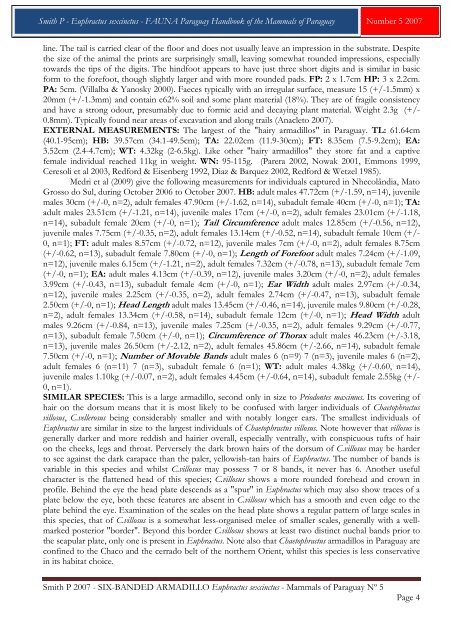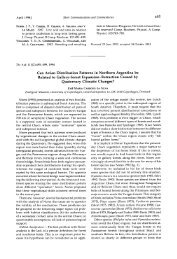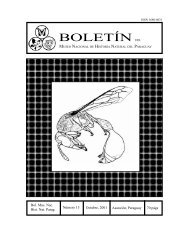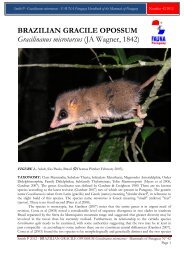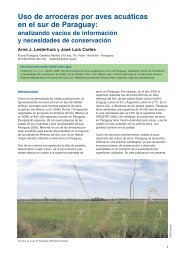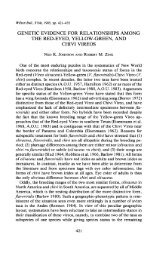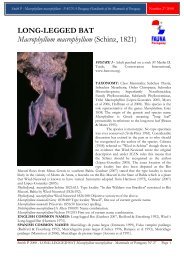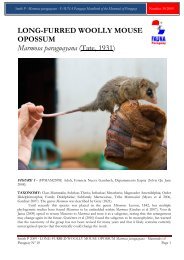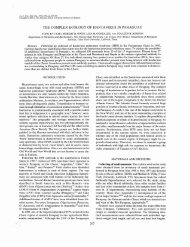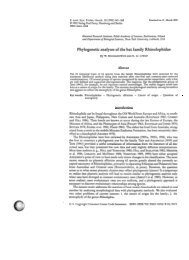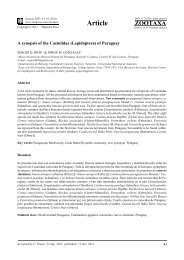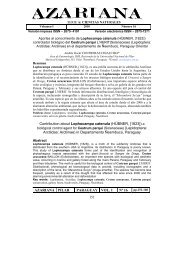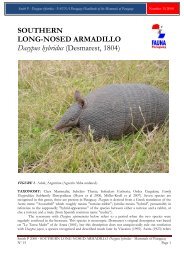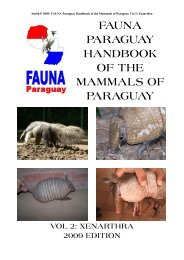Smith P 2007 - FAUNA Paraguay Handbook of the
Smith P 2007 - FAUNA Paraguay Handbook of the
Smith P 2007 - FAUNA Paraguay Handbook of the
Create successful ePaper yourself
Turn your PDF publications into a flip-book with our unique Google optimized e-Paper software.
<strong>Smith</strong> P - Euphractus sexcinctus - <strong>FAUNA</strong> <strong>Paraguay</strong> <strong>Handbook</strong> <strong>of</strong> <strong>the</strong> Mammals <strong>of</strong> <strong>Paraguay</strong> Number 5 <strong>2007</strong><br />
line. The tail is carried clear <strong>of</strong> <strong>the</strong> floor and does not usually leave an impression in <strong>the</strong> substrate. Despite<br />
<strong>the</strong> size <strong>of</strong> <strong>the</strong> animal <strong>the</strong> prints are surprisingly small, leaving somewhat rounded impressions, especially<br />
towards <strong>the</strong> tips <strong>of</strong> <strong>the</strong> digits. The hindfoot appears to have just three short digits and is similar in basic<br />
form to <strong>the</strong> forefoot, though slightly larger and with more rounded pads. FP: 2 x 1.7cm HP: 3 x 2.2cm.<br />
PA: 5cm. (Villalba & Yanosky 2000). Faeces typically with an irregular surface, measure 15 (+/-1.5mm) x<br />
20mm (+/-1.3mm) and contain c62% soil and some plant material (18%). They are <strong>of</strong> fragile consistency<br />
and have a strong odour, presumably due to formic acid and decaying plant material. Weight 2.3g (+/-<br />
0.8mm). Typically found near areas <strong>of</strong> excavation and along trails (Anacleto <strong>2007</strong>).<br />
EXTERNAL MEASUREMENTS: The largest <strong>of</strong> <strong>the</strong> "hairy armadillos" in <strong>Paraguay</strong>. TL: 61.64cm<br />
(40.1-95cm); HB: 39.57cm (34.1-49.5cm); TA: 22.02cm (11.9-30cm); FT: 8.35cm (7.5-9.2cm); EA:<br />
3.52cm (2.4-4.7cm); WT: 4.32kg (2-6.5kg). Like o<strong>the</strong>r "hairy armadillos" <strong>the</strong>y store fat and a captive<br />
female individual reached 11kg in weight. WN: 95-115g. (Parera 2002, Nowak 2001, Emmons 1999,<br />
Ceresoli et al 2003, Redford & Eisenberg 1992, Diaz & Barquez 2002, Redford & Wetzel 1985).<br />
Medri et al (2009) give <strong>the</strong> following measurements for individuals captured in Nhecolândia, Mato<br />
Grosso do Sul, during October 2006 to October <strong>2007</strong>. HB: adult males 47.72cm (+/-1.59, n=14), juvenile<br />
males 30cm (+/-0, n=2), adult females 47.90cm (+/-1.62, n=14), subadult female 40cm (+/-0, n=1); TA:<br />
adult males 23.51cm (+/-1.21, n=14), juvenile males 17cm (+/-0, n=2), adult females 23.01cm (+/-1.18,<br />
n=14), subadult female 20cm (+/-0, n=1); Tail Circumference adult males 12.85cm (+/-0.56, n=12),<br />
juvenile males 7.75cm (+/-0.35, n=2), adult females 13.14cm (+/-0.52, n=14), subadult female 10cm (+/-<br />
0, n=1); FT: adult males 8.57cm (+/-0.72, n=12), juvenile males 7cm (+/-0, n=2), adult females 8.75cm<br />
(+/-0.62, n=13), subadult female 7.80cm (+/-0, n=1); Length <strong>of</strong> Forefoot adult males 7.24cm (+/-1.09,<br />
n=12), juvenile males 6.15cm (+/-1.21, n=2), adult females 7.32cm (+/-0.78, n=13), subadult female 7cm<br />
(+/-0, n=1); EA: adult males 4.13cm (+/-0.39, n=12), juvenile males 3.20cm (+/-0, n=2), adult females<br />
3.99cm (+/-0.43, n=13), subadult female 4cm (+/-0, n=1); Ear Width adult males 2.97cm (+/-0.34,<br />
n=12), juvenile males 2.25cm (+/-0.35, n=2), adult females 2.74cm (+/-0.47, n=13), subadult female<br />
2.50cm (+/-0, n=1); Head Length adult males 13.45cm (+/-0.46, n=14), juvenile males 9.80cm (+/-0.28,<br />
n=2), adult females 13.34cm (+/-0.58, n=14), subadult female 12cm (+/-0, n=1); Head Width adult<br />
males 9.26cm (+/-0.84, n=13), juvenile males 7.25cm (+/-0.35, n=2), adult females 9.29cm (+/-0.77,<br />
n=13), subadult female 7.50cm (+/-0, n=1); Circumference <strong>of</strong> Thorax adult males 46.23cm (+/-3.18,<br />
n=13), juvenile males 26.50cm (+/-2.12, n=2), adult females 45.86cm (+/-2.66, n=14), subadult female<br />
7.50cm (+/-0, n=1); Number <strong>of</strong> Movable Bands adult males 6 (n=9) 7 (n=3), juvenile males 6 (n=2),<br />
adult females 6 (n=11) 7 (n=3), subadult female 6 (n=1); WT: adult males 4.38kg (+/-0.60, n=14),<br />
juvenile males 1.10kg (+/-0.07, n=2), adult females 4.45cm (+/-0.64, n=14), subadult female 2.55kg (+/-<br />
0, n=1).<br />
SIMILAR SPECIES: This is a large armadillo, second only in size to Priodontes maximus. Its covering <strong>of</strong><br />
hair on <strong>the</strong> dorsum means that it is most likely to be confused with larger individuals <strong>of</strong> Chaetophractus<br />
villosus, C.vellerosus being considerably smaller and with notably longer ears. The smallest individuals <strong>of</strong><br />
Euphractus are similar in size to <strong>the</strong> largest individuals <strong>of</strong> Chaetophractus villosus. Note however that villosus is<br />
generally darker and more reddish and hairier overall, especially ventrally, with conspicuous tufts <strong>of</strong> hair<br />
on <strong>the</strong> cheeks, legs and throat. Perversely <strong>the</strong> dark brown hairs <strong>of</strong> <strong>the</strong> dorsum <strong>of</strong> C.villosus may be harder<br />
to see against <strong>the</strong> dark carapace than <strong>the</strong> paler, yellowish-tan hairs <strong>of</strong> Euphractus. The number <strong>of</strong> bands is<br />
variable in this species and whilst C.villosus may possess 7 or 8 bands, it never has 6. Ano<strong>the</strong>r useful<br />
character is <strong>the</strong> flattened head <strong>of</strong> this species; C.villosus shows a more rounded forehead and crown in<br />
pr<strong>of</strong>ile. Behind <strong>the</strong> eye <strong>the</strong> head plate descends as a "spur" in Euphractus which may also show traces <strong>of</strong> a<br />
plate below <strong>the</strong> eye, both <strong>the</strong>se features are absent in C.villosus which has a smooth and even edge to <strong>the</strong><br />
plate behind <strong>the</strong> eye. Examination <strong>of</strong> <strong>the</strong> scales on <strong>the</strong> head plate shows a regular pattern <strong>of</strong> large scales in<br />
this species, that <strong>of</strong> C.villosus is a somewhat less-organised melee <strong>of</strong> smaller scales, generally with a wellmarked<br />
posterior "border". Beyond this border C.villosus shows at least two distinct nuchal bands prior to<br />
<strong>the</strong> scapular plate, only one is present in Euphractus. Note also that Chaetophractus armadillos in <strong>Paraguay</strong> are<br />
confined to <strong>the</strong> Chaco and <strong>the</strong> cerrado belt <strong>of</strong> <strong>the</strong> nor<strong>the</strong>rn Orient, whilst this species is less conservative<br />
in its habitat choice.<br />
<strong>Smith</strong> P <strong>2007</strong> - SIX-BANDED ARMADILLO Euphractus sexcinctus - Mammals <strong>of</strong> <strong>Paraguay</strong> Nº 5<br />
Page 4


